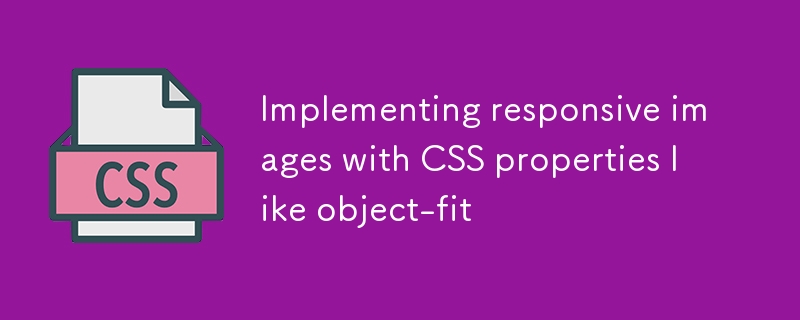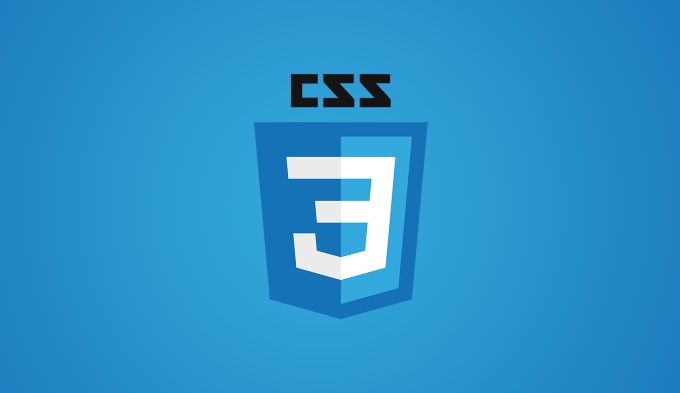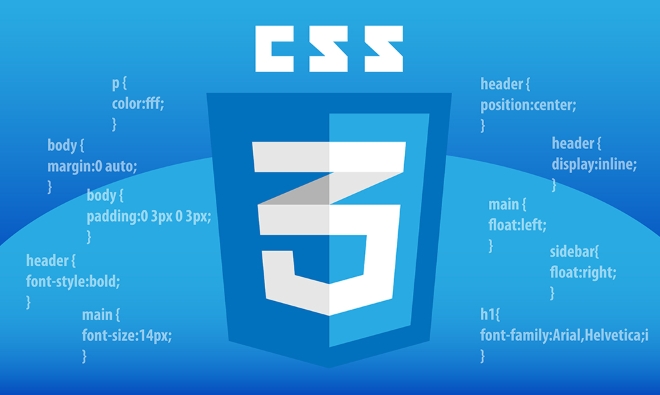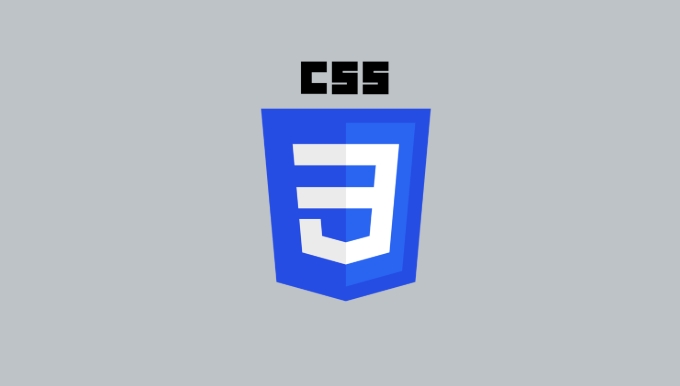Implementing responsive images with CSS properties like object-fit
Jul 13, 2025 am 01:40 AMTo make the images appear properly on different devices, object-fit, responsive layout and srcset technology are required. 1. object-fit controls the image scaling method. Common values include fill, contain, cover, scale-down, which is suitable for img and video elements; 2. Use @media query to realize layout adjustments under different screens, such as full width on the mobile phone and side-by-side display on the desktop; 3. Use srcset and sizes to let the browser select appropriate image resources according to the viewport to improve loading performance; 4. Pay attention to setting width and height to prevent layout jitter, avoiding misuse of object-fit in the background image, optimizing the quality of the original image and fully testing compatibility.

The proper display of pictures on different devices is an important part of modern web design. It is far from enough to rely on the img tag itself. Combining CSS attributes such as object-fit and responsive skills can truly make the picture "smart" adapt to various screens.

1. Understand the role and usage scenarios of object-fit
object-fit is a key property that controls how an image scales and aligns within its container. It has several commonly used values:

-
fill: stretching and filling the container (may deform) -
contain: Keep scaled to ensure the entire image is visible -
cover: Keep proportional cropping to ensure the container is filled -
scale-down: Take the smaller scale innoneandcontain
For example, if you are making a card component, the pictures inside are highly unified but the sources are different, using object-fit: cover can ensure that the visual consistency will not occur without black edges or deformation.
It should be noted that object-fit is only valid for img elements and video elements, but is not valid for background images. If you are using background-image , use background-size to achieve similar results.

2. Implement responsive image layout in combination with @media query
Images may require different display methods for different screen sizes. For example, on the mobile phone, you want the full width of the picture to be displayed; on the desktop, you may want to display several pictures side by side.
You can write this way:
img.responsive {
width: 100%;
height: auto;
}
@media (min-width: 768px) {
.responsive-card img {
width: 50%;
height: auto;
}
}In the example above, the image is full width by default, but when the screen width exceeds 768px, it becomes two columns side by side. This practice is very common and is especially suitable for article pages in content management systems.
Also, don't forget to set max-width: 100% to prevent image overflow from containers, which is one of the basic operations of responsive design.
3. Use srcset and sizes to let the browser choose the appropriate image resource
In addition to CSS, HTML can also be optimized. The <img src="/static/imghw/default1.png" data-src="image-small.jpg" class="lazy" alt="Implementing responsive images with CSS properties like object-fit" > tag supports srcset and sizes attributes, allowing you to provide multiple pictures with different resolutions and tell the browser to select the most appropriate resource based on the current viewport size.
Example:
<img src="/static/imghw/default1.png" data-src="image-small.jpg" class="lazy" srcset="image-small.jpg 480w, image-medium.jpg 800w, image-large.jpg 1200w" sizes="(max-width: 600px) 100vw, 50vw" alt="Responsive image" >
This code means:
- When the screen is less than 600px, use the full screen width (100vw) to load the picture of the corresponding size;
- Otherwise, load with half width (50vw).
This can reduce unnecessary large image loading and improve performance, especially for mobile users.
4. Frequently Asked Questions and Precautions
- Forgot to set
heightorwidth: it can easily cause layout jitter (CLS) and affect the user experience. - Misuse
object-fiton the background image : Remember to usebackground-sizeon the background image. - Ignore image quality : Even if responsive technology is used, if the original image is too large and heavy, it will also affect the loading speed.
- Inadequate testing : Different browsers have slightly different support for
object-fit, especially for older IE versions, polyfill can be added if necessary.
Basically that's it. The rational use of object-fit , srcset and media queries can make images perform more naturally on various devices and improve page loading efficiency. Although the details are small, the combination is obvious.
The above is the detailed content of Implementing responsive images with CSS properties like object-fit. For more information, please follow other related articles on the PHP Chinese website!

Hot AI Tools

Undress AI Tool
Undress images for free

Undresser.AI Undress
AI-powered app for creating realistic nude photos

AI Clothes Remover
Online AI tool for removing clothes from photos.

Clothoff.io
AI clothes remover

Video Face Swap
Swap faces in any video effortlessly with our completely free AI face swap tool!

Hot Article

Hot Tools

Notepad++7.3.1
Easy-to-use and free code editor

SublimeText3 Chinese version
Chinese version, very easy to use

Zend Studio 13.0.1
Powerful PHP integrated development environment

Dreamweaver CS6
Visual web development tools

SublimeText3 Mac version
God-level code editing software (SublimeText3)

Hot Topics
 What is 'render-blocking CSS'?
Jun 24, 2025 am 12:42 AM
What is 'render-blocking CSS'?
Jun 24, 2025 am 12:42 AM
CSS blocks page rendering because browsers view inline and external CSS as key resources by default, especially with imported stylesheets, header large amounts of inline CSS, and unoptimized media query styles. 1. Extract critical CSS and embed it into HTML; 2. Delay loading non-critical CSS through JavaScript; 3. Use media attributes to optimize loading such as print styles; 4. Compress and merge CSS to reduce requests. It is recommended to use tools to extract key CSS, combine rel="preload" asynchronous loading, and use media delayed loading reasonably to avoid excessive splitting and complex script control.
 External vs. Internal CSS: What's the Best Approach?
Jun 20, 2025 am 12:45 AM
External vs. Internal CSS: What's the Best Approach?
Jun 20, 2025 am 12:45 AM
ThebestapproachforCSSdependsontheproject'sspecificneeds.Forlargerprojects,externalCSSisbetterduetomaintainabilityandreusability;forsmallerprojectsorsingle-pageapplications,internalCSSmightbemoresuitable.It'scrucialtobalanceprojectsize,performanceneed
 Does my CSS must be on lower case?
Jun 19, 2025 am 12:29 AM
Does my CSS must be on lower case?
Jun 19, 2025 am 12:29 AM
No,CSSdoesnothavetobeinlowercase.However,usinglowercaseisrecommendedfor:1)Consistencyandreadability,2)Avoidingerrorsinrelatedtechnologies,3)Potentialperformancebenefits,and4)Improvedcollaborationwithinteams.
 CSS Case Sensitivity: Understanding What Matters
Jun 20, 2025 am 12:09 AM
CSS Case Sensitivity: Understanding What Matters
Jun 20, 2025 am 12:09 AM
CSSismostlycase-insensitive,butURLsandfontfamilynamesarecase-sensitive.1)Propertiesandvalueslikecolor:red;arenotcase-sensitive.2)URLsmustmatchtheserver'scase,e.g.,/images/Logo.png.3)Fontfamilynameslike'OpenSans'mustbeexact.
 What is Autoprefixer and how does it work?
Jul 02, 2025 am 01:15 AM
What is Autoprefixer and how does it work?
Jul 02, 2025 am 01:15 AM
Autoprefixer is a tool that automatically adds vendor prefixes to CSS attributes based on the target browser scope. 1. It solves the problem of manually maintaining prefixes with errors; 2. Work through the PostCSS plug-in form, parse CSS, analyze attributes that need to be prefixed, and generate code according to configuration; 3. The usage steps include installing plug-ins, setting browserslist, and enabling them in the build process; 4. Notes include not manually adding prefixes, keeping configuration updates, prefixes not all attributes, and it is recommended to use them with the preprocessor.
 What are CSS counters?
Jun 19, 2025 am 12:34 AM
What are CSS counters?
Jun 19, 2025 am 12:34 AM
CSScounterscanautomaticallynumbersectionsandlists.1)Usecounter-resettoinitialize,counter-incrementtoincrease,andcounter()orcounters()todisplayvalues.2)CombinewithJavaScriptfordynamiccontenttoensureaccurateupdates.
 CSS: When Does Case Matter (and When Doesn't)?
Jun 19, 2025 am 12:27 AM
CSS: When Does Case Matter (and When Doesn't)?
Jun 19, 2025 am 12:27 AM
In CSS, selector and attribute names are case-sensitive, while values, named colors, URLs, and custom attributes are case-sensitive. 1. The selector and attribute names are case-insensitive, such as background-color and background-Color are the same. 2. The hexadecimal color in the value is case-sensitive, but the named color is case-sensitive, such as red and Red is invalid. 3. URLs are case sensitive and may cause file loading problems. 4. Custom properties (variables) are case sensitive, and you need to pay attention to the consistency of case when using them.
 What is the conic-gradient() function?
Jul 01, 2025 am 01:16 AM
What is the conic-gradient() function?
Jul 01, 2025 am 01:16 AM
Theconic-gradient()functioninCSScreatescirculargradientsthatrotatecolorstopsaroundacentralpoint.1.Itisidealforpiecharts,progressindicators,colorwheels,anddecorativebackgrounds.2.Itworksbydefiningcolorstopsatspecificangles,optionallystartingfromadefin






